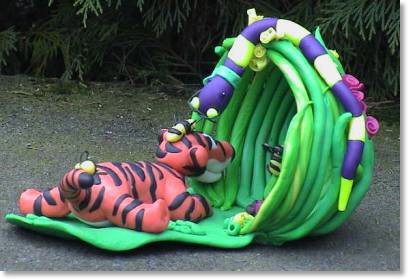|
What is it?
It is a modeling material, easy to handle and available
in several colours, that consists of PVC and plastisizer.
Creall-therm
meets the European safety standard for toys, EN 71-5
and the American standard ASTM (AP-NON toxic). FIMO meets the American safety standard ASTM D-4236.
This material, especially Fimo Classic, requires
kneading to make it pliable.
Advantages:
 the clay is available in several colours and textures.
the clay is available in several colours and textures.
 it can be hardened in a kitchen oven, max. 110 degrees
C (approx. 30 minutes).
it can be hardened in a kitchen oven, max. 110 degrees
C (approx. 30 minutes).
 it can be hardened several times, allowing you to add
things. The same hardening time and temperature.
it can be hardened several times, allowing you to add
things. The same hardening time and temperature.
 you can work at your creation several days, if necessary,
everytime adding a new part. Cover it against dust.
you can work at your creation several days, if necessary,
everytime adding a new part. Cover it against dust.
 it can be stored in their original packaging for several
years. Store unpacked material wrapped in aluminium
foil, in tins or plastic bags.
it can be stored in their original packaging for several
years. Store unpacked material wrapped in aluminium
foil, in tins or plastic bags.
 it is not necessary, but you can varnish or paint your
creation (acrylic paints / special Fimo varnish is available
in two qualities: solvent- or water-based, matt or gloss).
it is not necessary, but you can varnish or paint your
creation (acrylic paints / special Fimo varnish is available
in two qualities: solvent- or water-based, matt or gloss).
 you can use it on many materials, like wood, iron, glass.
you can use it on many materials, like wood, iron, glass.
 used Fimo can be disposed with the normal refuse.
used Fimo can be disposed with the normal refuse.
 
Disadvantages:
 polymer clay could pick up dust and other stuff from
your work place so keep it clean.
polymer clay could pick up dust and other stuff from
your work place so keep it clean.
 when hardening it can smell a bit when
you use a too high temperature (more information click
here). Ventilate the room the
oven is in.
when hardening it can smell a bit when
you use a too high temperature (more information click
here). Ventilate the room the
oven is in.
 some colours, especially the darker ones, come off.
So you have to wash your hands during kneading.
some colours, especially the darker ones, come off.
So you have to wash your hands during kneading.
 it is not cheap, best to shop before you buy.
it is not cheap, best to shop before you buy.
Important:
 be sure to have warm hands, it helps modeling the clay.
be sure to have warm hands, it helps modeling the clay.
 let the workpiece cool off by itself (in the oven).
let the workpiece cool off by itself (in the oven).
 do not harden your workpiece at more than 110 degrees
C, otherwise your workpiece may burn
a bit.
do not harden your workpiece at more than 110 degrees
C, otherwise your workpiece may burn
a bit.
 it is better to use a low temperature and longer baking
time (up to 50 minutes is possible; sometimes necessary
with fragile things).
it is better to use a low temperature and longer baking
time (up to 50 minutes is possible; sometimes necessary
with fragile things).
Tips and additional information:
 you could keep your hands clean and help generating
some warmth from your hands to the clay if you would
put some Vaseline on your hands.
you could keep your hands clean and help generating
some warmth from your hands to the clay if you would
put some Vaseline on your hands.
 frequently asked questions about Polymer Clay can be found here.
frequently asked questions about Polymer Clay can be found here.
 you will find a non-scientific test on five different polymer clays commonly used by artisans
and crafters at gigagraphica.
you will find a non-scientific test on five different polymer clays commonly used by artisans
and crafters at gigagraphica.
 tips
& technique from down under.
tips
& technique from down under.

|












